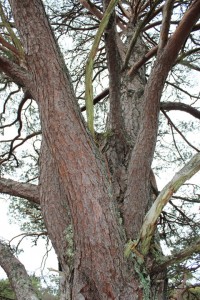 There are many iconic things to see in the Highlands as far as wildlife is concerned and most are well established, well known and well publicised. Some of the more obvious ones include golden eagles, salmon leaping, capercaillie, red deer stags and the dolphins at various places around the coasts. One iconic image that is often forgotten or overlooked is the Scots pine yet it is one of , if not the most, important tree of the landscape. In the last few weeks the Scots pine has drawn the attention of the media in its various forms. One item that surprised me was the idea being spread around that we ought to have a national vote as to which tree in Scotland should be the Scottish emblem. For some reason I always accepted that because of its role in the past and present the Scots pine was that “emblem”. For example, it is commonly referred to as the “King of the Forest” whilst the “Queen of the Forest” is the silver birch. In the past it was always, and in some cases still is, the emblem or Clan badge of at least seven Clans including Gunn, Macgregor and Macauley.
There are many iconic things to see in the Highlands as far as wildlife is concerned and most are well established, well known and well publicised. Some of the more obvious ones include golden eagles, salmon leaping, capercaillie, red deer stags and the dolphins at various places around the coasts. One iconic image that is often forgotten or overlooked is the Scots pine yet it is one of , if not the most, important tree of the landscape. In the last few weeks the Scots pine has drawn the attention of the media in its various forms. One item that surprised me was the idea being spread around that we ought to have a national vote as to which tree in Scotland should be the Scottish emblem. For some reason I always accepted that because of its role in the past and present the Scots pine was that “emblem”. For example, it is commonly referred to as the “King of the Forest” whilst the “Queen of the Forest” is the silver birch. In the past it was always, and in some cases still is, the emblem or Clan badge of at least seven Clans including Gunn, Macgregor and Macauley.
The Scots pine is worthy of any accolades mainly because once the ice had retracted from Britain only one large conifer was able to colonise the landscape left after the ice retreated and that was the Scots pine. Its uses have been varied , for example at one time it was the major source of turpentine, resin and tar, its wood was used for charcoal and for making flaming torches. It was this surviving the aftermath of the ice age that also included it in the list of, arguably, only three conifers that are native to the Highlands. An obvious other one is the juniper that is often growing as an understory to the Scots pine. There are superb examples of this partnership in the three glens of Affric, Cannich and Strathfarrar lying to the west of Inverness. The junipers in these three glens often grow over three metres or more and they, combined with the Scots pine, birch, aspen and rowan are important remnants of the formerly widespread ancient Caledonian pine forest.
Historically there has always been three natïve conifers in the Highlands with, apart from the Scots pine and the juniper, the other being the yew tree. Now, however, there seems to be, for some reason, doubt over the fact that the yew is a native tree. This is despite the fact that some of them are very old. The reason for this doubt is not certain but it only serves to put the other two, namely the Scots pine and juniper into perspective. The suggestion is that the only evidence of the yew being native are the yew “woodlands”, in Argyll. It will be interesting to see whether this problem about the status of the yew is resolved, one way or the other. Most of the yews we see are in old churchyards or burial grounds where in many case the yew trees did not come first. It appears that the yew has long been held sacred and were found on such ground well before the current buildings were erected as much more traditional religious sites. It has always been presumed that yew trees were used as the timber to make the old longbows. In fact the yews in the UK were not very suitable and most of the yews used in this way came for the continent such as Spain.
